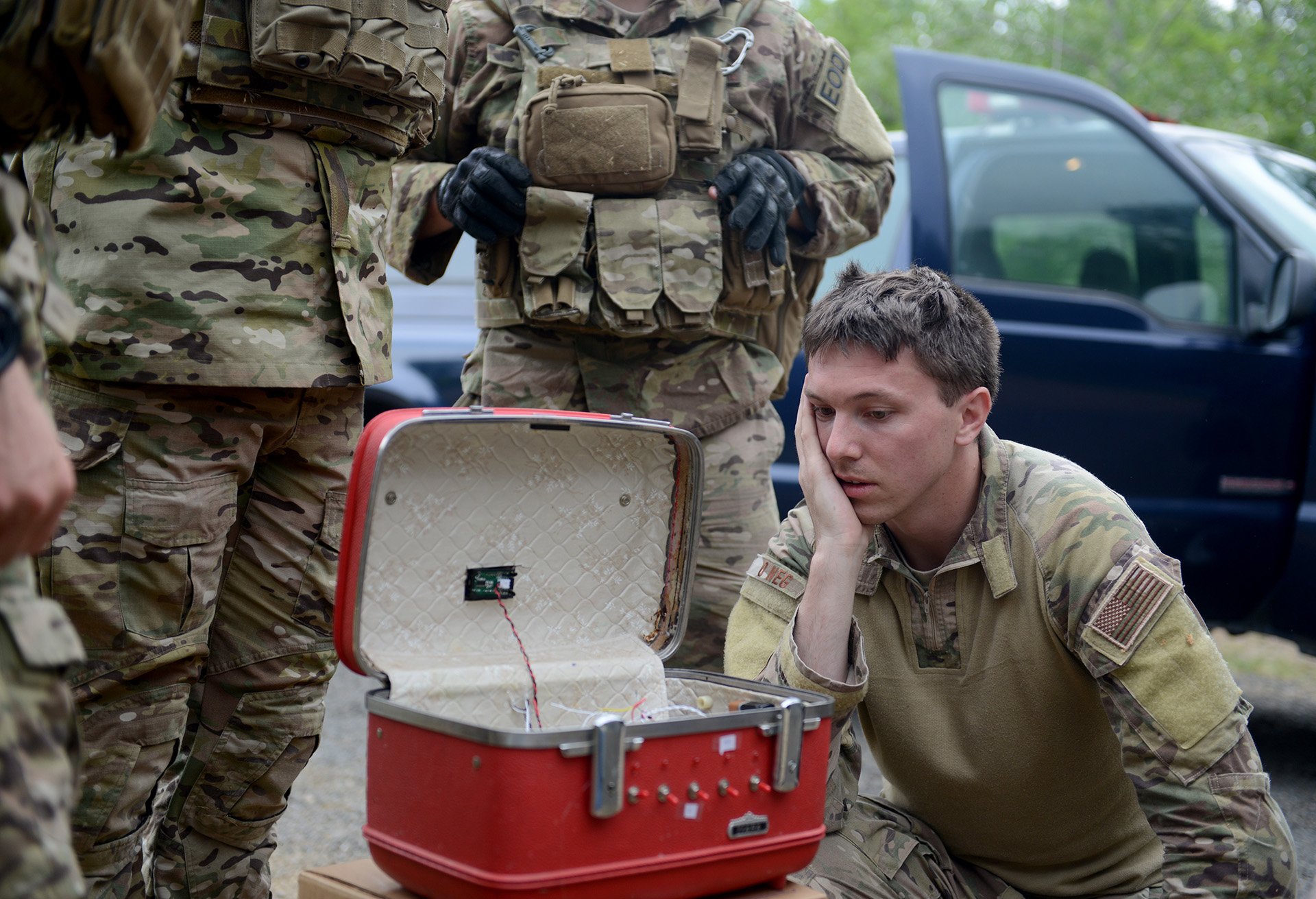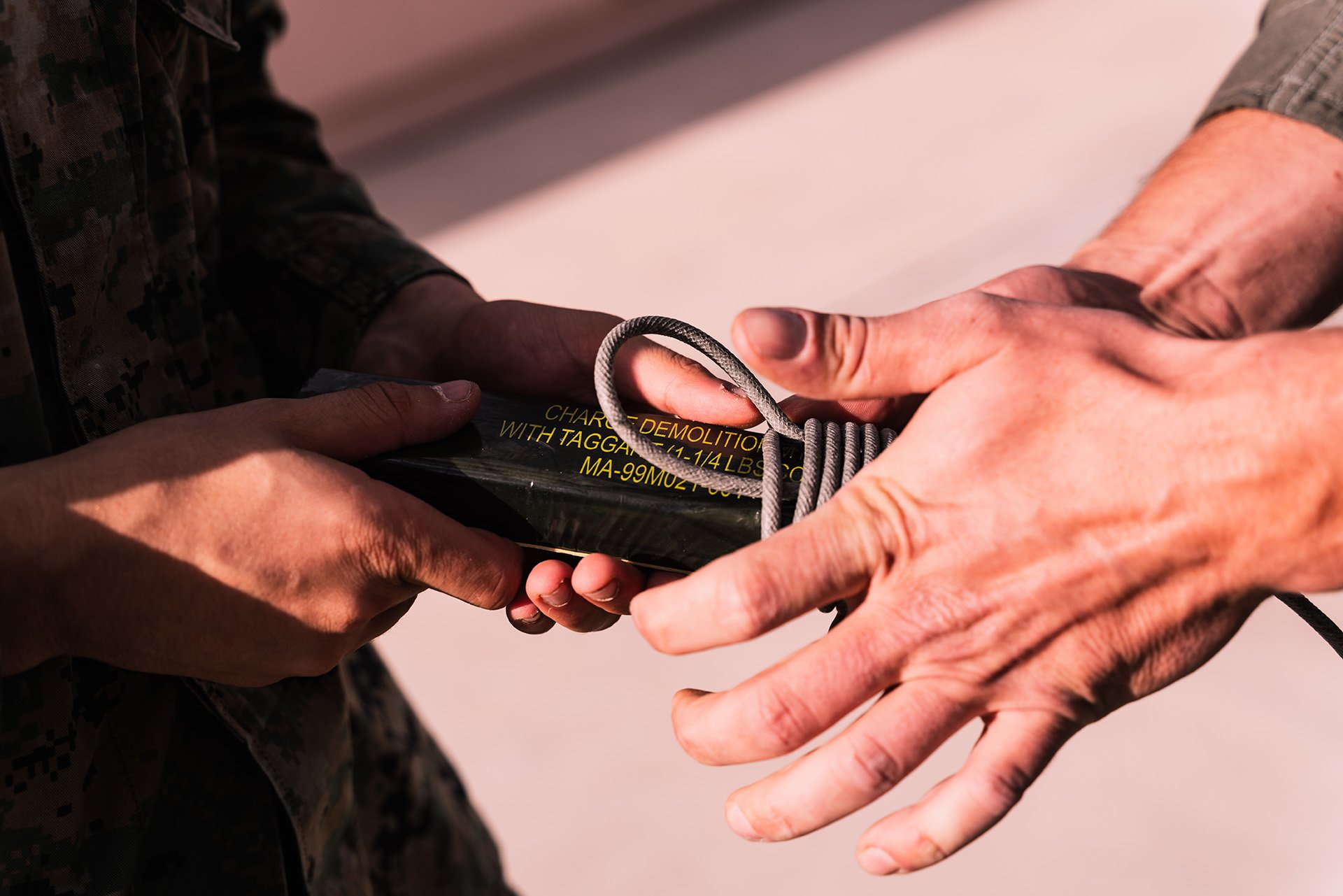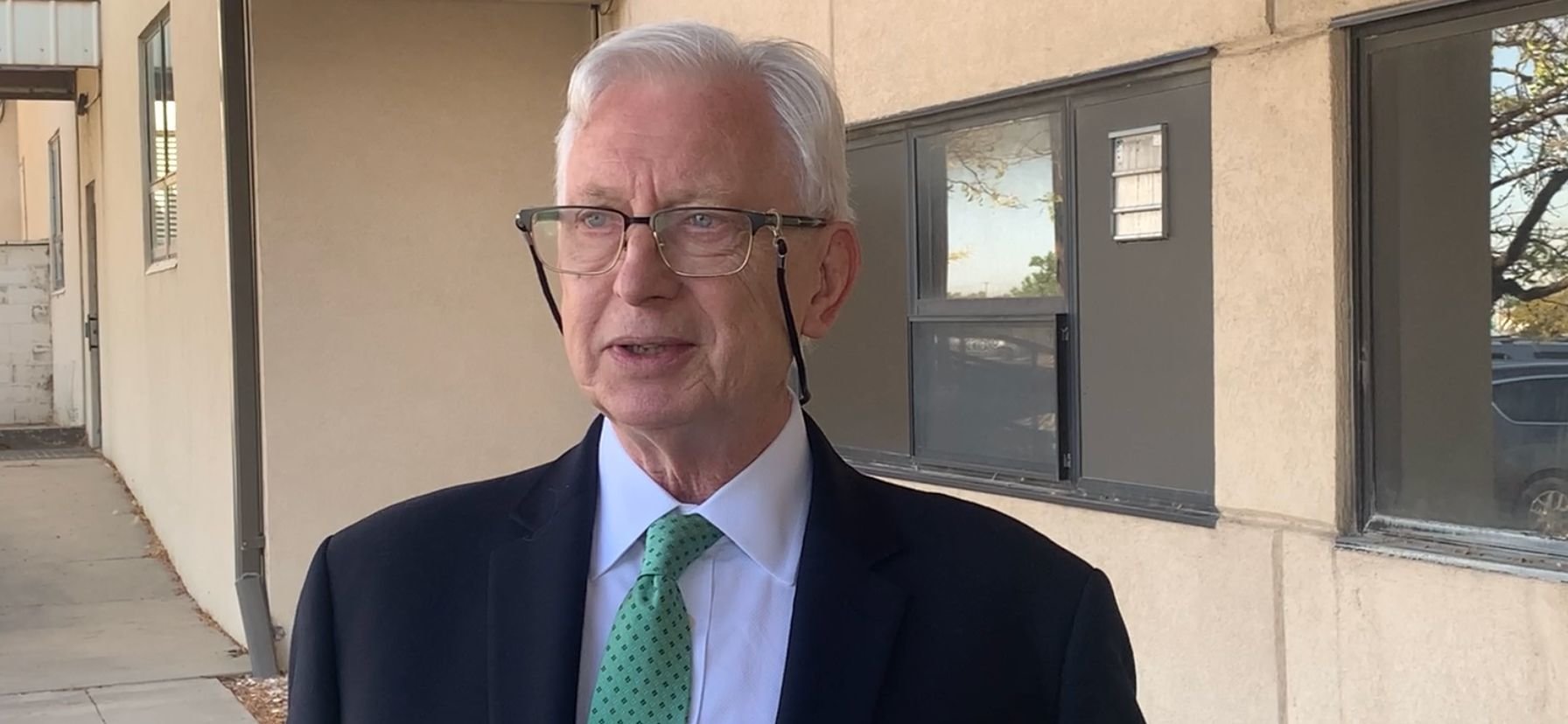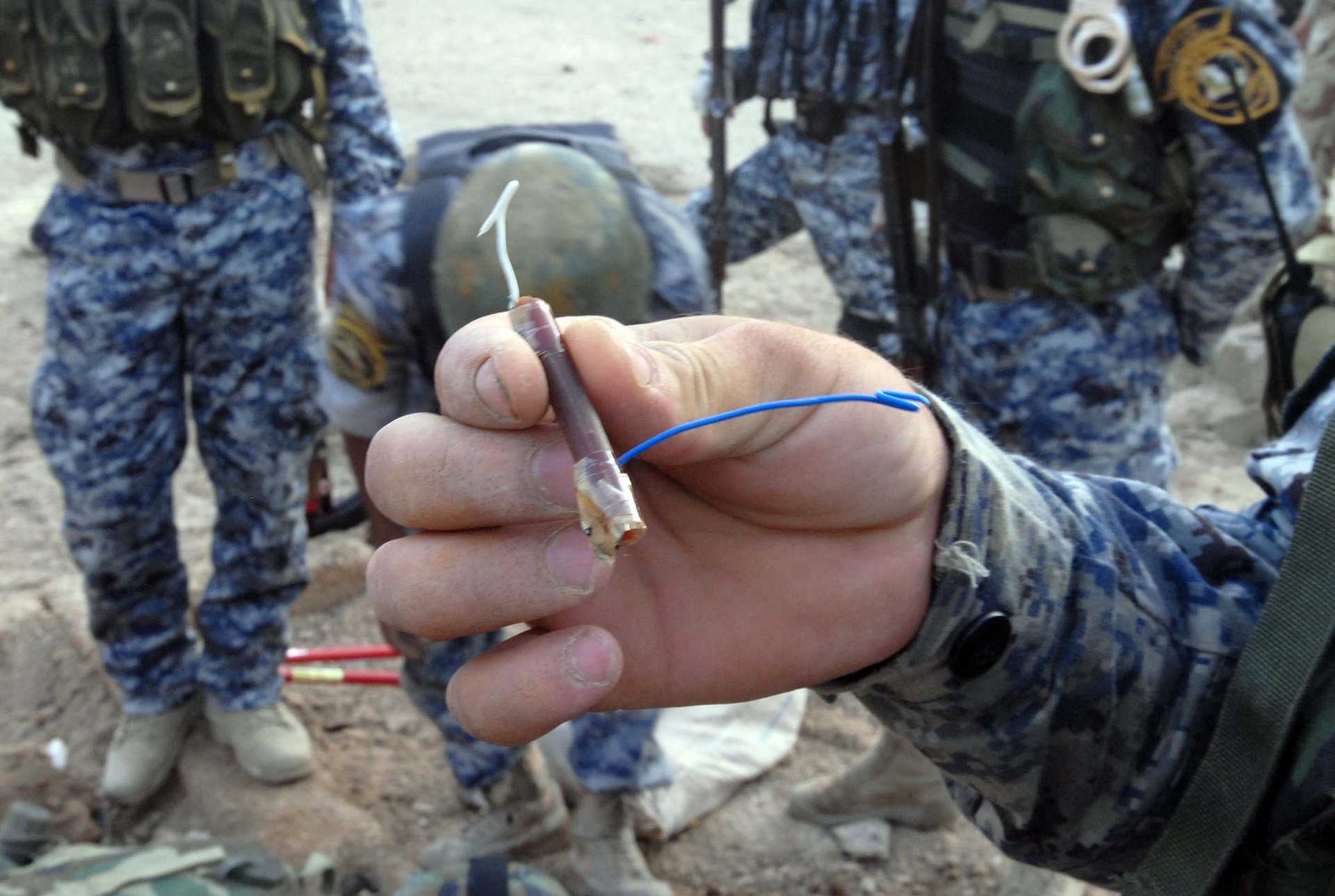Air Force Case Against Alleged Syria Saboteur Hinges on ‘Circumstantial Evidence’

Then-Staff Sgt. David Dezwaan (left), and Airman 1st Class Alex Nona at Clear Lake, California in 2016. The EOD technicians participated in Operation: Half-Life, an exercise designed to evaluate a synchronized, multi-agency response to a crisis-situation. (U.S. Air Force photo by Senior Airman Bobby Cummings)
Citing “overwhelming circumstantial evidence,” while admitting the quality of a key video tape is “not great,” Air Force officials laid out evidence and a timeline that they said pointed toward Tech. Sgt. David Dezwaan Jr. as the sole saboteur in an April insider attack at a US base in Syria.
Yet Dezwaan’s defense team got Air Force officials to admit on the stand that no direct physical evidence tied Dezwaan to the bombing that injured four, including Dezwaan, at an Article 32 hearing at Hill Air Force Base, Utah.
The Article 32 hearing, held Tuesday, Aug. 23, was a preliminary step in the military justice process toward a court-martial, in which prosecutors had to convince a senior officer — though not a judge — that enough evidence exists to proceed to a full court-martial.
Dezwaan was a senior explosive ordnance disposal, or EOD, technician at a US outpost known as Green Village in Syria in April. EOD techs have specialized training that prosecutors said gave Dezwaan plenty of know-how to create and detonate two bombs in quick succession at the small US base.

A 2016 picture of then-Staff Sgt. David Dezwaan, as he inspects the wiring of a simulated radioactive dispersal device at Clear Lake, California. Dezwaan was charged with planting explosives at a US base in Syria which injured four Americans. Air Force photo by Senior Airman Bobby Cummings.
“He drew each individual to one area,” Capt. Taylor Brown of the Air Force prosecution team said. “He had complete disregard of the probable consequences.”
But Dezwaan’s lawyers hammered on a lack of physical evidence or witnesses linking him to the explosion.
“There’s just no probable cause in this case,” Dezwaan’s lead civilian defense counsel, Nathan Freeburg, told the military hearing officer, an Air Force colonel. He claimed Dezwaan was singled out by investigators because of his preferences for role-playing games over video games and was described as “weird” by his some who knew him.
Dezwaan has been in pretrial confinement at the Weber County Correctional Facility since June 16.
During cross-examination by Dezwaan's defense team, an Air Force Office of Special Investigations agent confirmed that no fingerprints, DNA, or other physical evidence were found in the remnants of the attack that linked the Air Force explosives expert to the blast devices.
Air Force officials said Dezwaan had planted two bombs near a shower unit and an ammo holding area at 1:07 a.m. and 1:10 a.m on April 7. He faces five charges from the blasts, including counts of willful dereliction of duty, destruction of government property, theft of classified documents, and aggravated assault. The assault charge covers the three injured in the blast who were later diagnosed with traumatic brain injuries, according to the charging documents.
The Air Force also claims Dezwaan destroyed two shipping containers holding C4, blasting caps, standard EOD kits, timed fuses, and a few grenades, as well as other trailers and buildings worth more than $50,000.

C4 explosive is wrapped with detonation cord during demo day at Marine Corps Air Ground Combat Center Twentynine Palms, California, Oct. 17, 2019. Investigators believe Tech. Sgt. David Dezwaan used detonation cord as a fuse to set off C4 charges, shown similarly in this photo, near the shower-latrine area and an ammunition storage point. US Marine Corps photo by Lance Cpl. Colton Brownlee.
The hearing officer, Col. Brian Thompson, a staff judge advocate from 3rd Air Force at Ramstein Air Base, Germany, will consider the defense and prosecution arguments and recommend whether the case should proceed to a full court-martial.
In the half-day hearing, prosecutors did not introduce evidence of a motive and admitted that surveillance footage of the blast area from several cameras was low quality. Although some footage shows a figure walking around the blast site, two of the cameras recording that night were infrared and another cut out every five seconds to a black screen. The Air Force did not show the camera footage in court, and the Air Force’s Office of Special Investigations Special Agent Timothy Weinhold described the videos as “not great.”
Instead, Air Force officials relied heavily on a provisional timeline built by investigators over the course of a few months and what one prosecutor called “overwhelming circumstantial evidence.” Dezwaan, they said, was an explosives expert with access to the tools to commit the crime, opportunity, and specialized knowledge.
Phil Cave, part of Dezwaan’s civilian legal team, told Coffee or Die Magazine that the government had dragged its feet in turning over evidence, including the video tapes. Cave said he believed the Air Force’s slow response to evidence discovery could lead to dismissal of all charges on the grounds of violating the defendant’s right to a speedy trial.

Phil Cave, one of Dezwaan’s civilian lawyers from Cave & Freeburg LLP, spoke with reporters after the hearing. “The government has no explanation for why Tech. Sgt. Dezwaan would blow himself up," Cave said. "We have requested a lot of information from the government, which they have been disinclined to give.” Photo by Lauren Coontz/Coffee or Die Magazine.
The biggest challenge, Cave said, was a lack of preserved evidence and the inability to visit the blast site. He said the Air Force had also not provided the classified documents Dezwaan was accused of stealing.
Air Force officials claimed Dezwaan had stolen a document marked with "Secret, No Foreign" classification — allegedly an EOD document detailing a chemical dispersal device. They additionally claimed he'd stolen four other secret documents, including a map of the Syrian area of operations.
Dezwaan’s defense team argued that these documents, along with one alleged to be a list of the troop movement cycles, could just as easily have been an attempt to find out when he and his team were leaving Syria for home. “Certainly an offense, but not one for a general court-martial to decide,” Freeburg said.
Not having the documents, Freeburg told the hearing officer, meant “we don’t just have one hand tied behind our back, but two hands."
Physical evidence collected at the site included a charred knife — collected days after the incident — with no fingerprints or DNA, a rag from a bunker nearby, soil samples, and some metal fragments. None, the defense said, could be explicitly linked to Dezwaan.

One of several blasting caps is pulled out of a weapons cache in an operation conducted by the 3rd Brigade, 1st Iraqi Army Division Quick Reaction Force, and the Iraqi national police, July 8, 2008, in Husseniaya, northeast of Baghdad. Blasting caps, used as initiators in improvised explosive devices, were among the equipment the Air Force claimed Tech. Sgt. David Dezwaan Jr. destroyed on April 7, 2022, in a bombing of a US military outpost in Syria known as Green Village. US Army photo by Sgt. Philip Klein.
Dezwaan did not take the stand in the hearing, but after the blast, he allowed OSI agents to search his phone and later confirmed a butane lighter found during the course of the investigation was his.
The prosecution also noted a stopwatch app was running on Dezwaan’s phone and ran for 44 minutes, stopping at 1:06 a.m., one minute before the first blast detonated.
Special Agent Weinhold said he believed Dezwaan had used detonator cord to ignite C4 explosive, a method Weinhold said would leave the least evidence and that most EOD techs would know. Weinhold also theorized that Dezwaan used detonator cord — which burns at 40 feet per second — as a fuse, timing the explosions with the stopwatch app.
Weinhold also noted that Dezwaan sent a text to an EOD group chat at 12:31 a.m. asking, “Hey, are the showers warm?” believing it to be evidence Dezwaan was attempting to act casually.
The government claimed Dezwaan’s wounds post-blast appeared to be self-inflicted by a knife, not by glass as he claimed.
Additionally, investigators said Dezwaan’s story had changed over time, though the defense attributes his memory lapses to traumatic brain injury from a prior deployment, as well as to a concussion suffered in the Green Village bombing.
The prosecution pointed toward an initial theory for motive that Dezwaan may have planted the explosives to earn a Combat Action Badge, but his defense noted that he had already been awarded one from a previous deployment.
If convicted, Dezwaan could face more than 10 years in prison and a dishonorable discharge. At the close of the hearing, Thompson said he hoped to present his conclusion and final recommendations for how the case should proceed early next week.
Read Next: UCMJ Charges: EOD Tech Set Off Bombs on US Base In Syria

Lauren Coontz is a former staff writer for Coffee or Die Magazine. Beaches are preferred, but Lauren calls the Rocky Mountains of Utah home. You can usually find her in an art museum, at an archaeology site, or checking out local nightlife like drag shows and cocktail bars (gin is key). A student of history, Lauren is an Army veteran who worked all over the world and loves to travel to see the old stuff the history books only give a sentence to. She likes medium roast coffee and sometimes, like a sinner, adds sweet cream to it.
BRCC and Bad Moon Print Press team up for an exclusive, limited-edition T-shirt design!
BRCC partners with Team Room Design for an exclusive T-shirt release!
Thirty Seconds Out has partnered with BRCC for an exclusive shirt design invoking the God of Winter.
Lucas O'Hara of Grizzly Forge has teamed up with BRCC for a badass, exclusive Shirt Club T-shirt design featuring his most popular knife and tiomahawk.
Coffee or Die sits down with one of the graphic designers behind Black Rifle Coffee's signature look and vibe.
Biden will award the Medal of Honor to a Vietnam War Army helicopter pilot who risked his life to save a reconnaissance team from almost certain death.
Ever wonder how much Jack Mandaville would f*ck sh*t up if he went back in time? The American Revolution didn't even see him coming.
A nearly 200-year-old West Point time capsule that at first appeared to yield little more than dust contains hidden treasure, the US Military Academy said.












